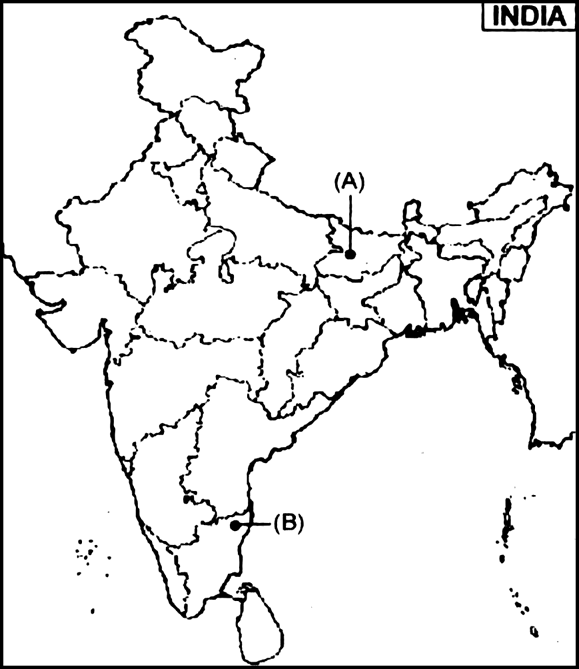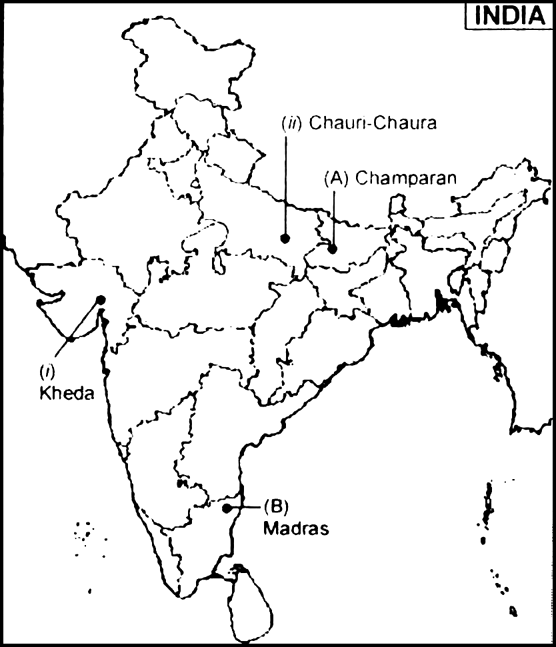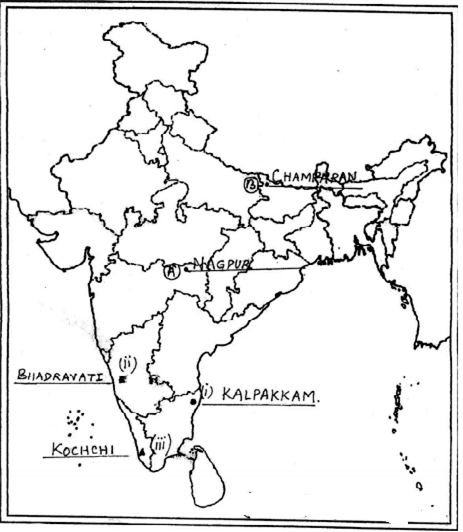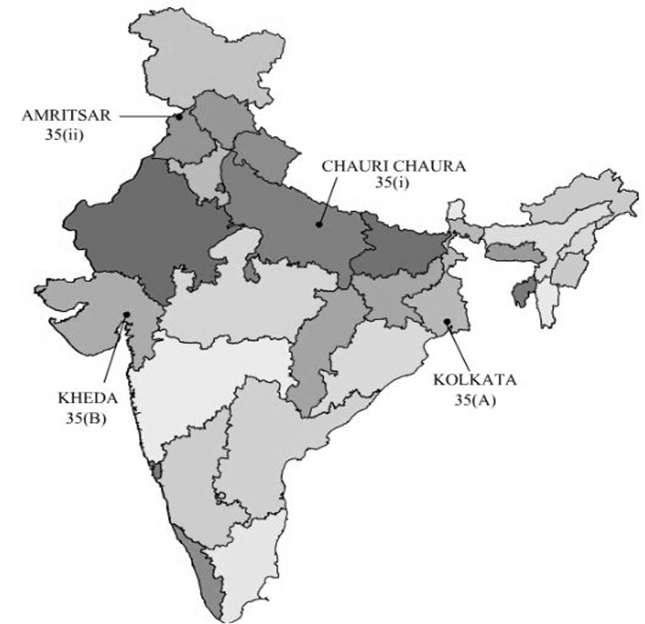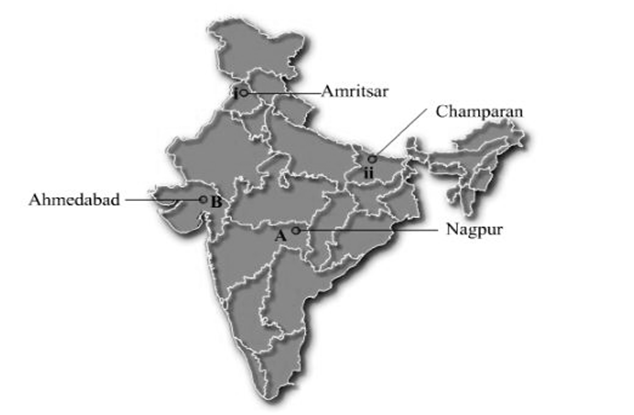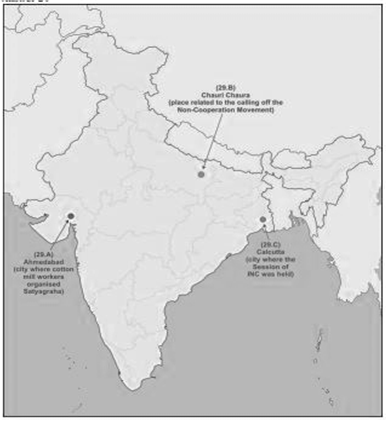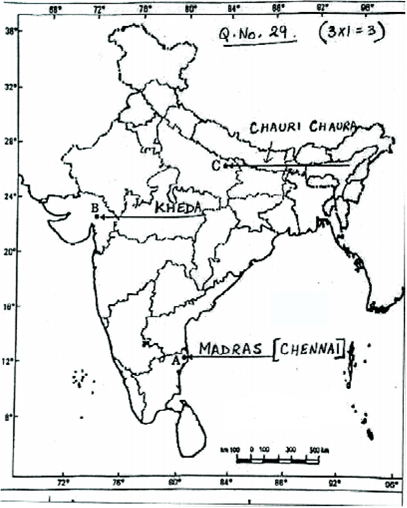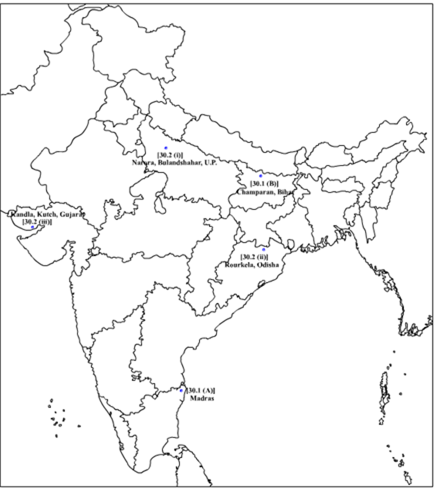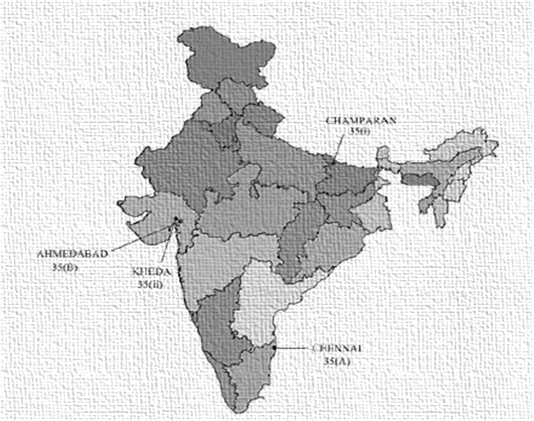India And The Contemporary World Ii Chapter 3 Nationalism In India
Sponsor Area
NCERT Solution For Class 10 Social+science India And The Contemporary World Ii
Why growth of nationalism in the colonies is linked to an anti-colonial movement?
The growth of nationalism in the colonies is linked to an anti-colonial movement because people began discovering their unity in the process of their struggle with colonialism.The sense of being oppressed under colonialism provided a shared bond that tied many different groups togrther.
How the First World War helped in the growth of the National Movement in India?
The First World War had created a new economic and political situation in India.
(i) It led to a huge increase in defence expenditures which was financed by war loans and increasing taxes.
(ii) Custom duties were raised and Income tax was introduced.
(iii) There was widespread anger in the rural area due to forced recruitment of soldiers.
Why Indians were outraged by the Rowlatt Act?
Rowlatt Act (1919) had given the government enormous powers to repress political activities and allowed detention of political prisoners without trial for two years.
Why Gandhiji decided to withdraw the Non-Cooperation Movement?
In February 1922, Gandhi decided to withdraw the Non-Cooperation Movement. He felt the movement was turning violent in many places and satyagrahis needed to be properly trained before they would be ready for mass struggles.
What is meant by the idea of satyagraha?
The idea of satyagraha emphasised the power of truth and the need to search for truth. It suggested that if the cause was true, if the struggle was against injustice, then physical force was not necessary to fight the oppressor.
The Jallianwala Bagh massacre
On 13 April 1919 the infamous Jallianwala Bagh took place. The innocent people of Punjab, who had gathered at Jallianwalla Bagh had to face the bullets of General Dyer. There were thousands of men, women and children. Most of the people were from outside Amritsar and had come to attend the annual ‘Baisakhi’ fair. As it is stated, General Dyer had issued a declaration prohibiting public meetings and imposition of martial law. Dyer entered the area and blocked all the exit points and without warning the unarmed crowd, ordered his troops to open fire on the crowd, killing hundreds. His object, as he declared later, was to 'produce a moral effect', to create in the minds off satyagrahis a feeling of terror and awe.
The Simon Commission
The Tory Government in Britain had constituted a Statutory Commission under Sir John Simon. Set up in response to the nationalist movement in India. The commission was to look into the functioning of the constitutional system in India and suggest changes. The problem was that the commission did not have a single Indian member. They were all British.
Compare the images of Bharat Mata in this chapter with the image of Germania in Chapter 1.
With the growth of nationalism, the identity of India came to be visually associated with the image of Bharat Mata. There are two images of Bharat Mata one by Abanindranath Tagore and the second by an other artist. In the image drawn by Tagore, Bharat Mata is portrayed as an ascetic figure. She has been shown as calm, composed, divine and spiritual. In the second figure drawn subsequently by another artist, Bharat Mata has been shown with a trishul in her hand, standing beside a lion and an elephant. Both are symbols of power and authority. Thus, in India, Bharat Mata has acquired many different forms from an ascetic figure to symbols of power and authority.
On the other hand, the image of Germania by Philip Veet wears a crown of oak leaves, as the German oak stands for heroism. Thus, there is one similarity between Bharat Mata and Germania that both contain elements of bravery i.e. power, authority and heroism.
List all the different social groups which joined the Non-Cooperation Movement of 1921. Then choose any three and write about their hopes and struggles to show why they joined the movement.
The list of social groups are:
(i) The workers and members of Congress Party.
(ii) The members of Khilafat Committee and supporters of Khilafat cause (or the Ottoman Turkey empire).
(iii) Middle class of the cities.
(iv) Students and teachers from schools and colleges.
(v) Merchants and traders.
(vi) The weavers.
(vii) The lawyers.
(viii) The peasants and the tribals.
(ix) Plantation workers.
Three social groups, their hopes and struggles :
(i) Middle Classes in the Cities : These mainly comprised students, teachers and lawyers. They responded enthusiastically to the call for non-cooperation and boycott. They saw the movement as a way to freedom from foreign domination. For example, khadi cloth was often more expensive than mass-produced mill cloth and poor people could not afford to buy it.
For the movement to be sucessful, alternative Indian institutions had to be set up so that they could be used in place of the British ones. Likewise, students and teachers had no choice but to go back to government schools. Likewise, lawyers had no choice but to go back to courts.
(ii) Peasants and Tribals : At many places, peasants joined the Non-Cooperation Movement. The movement was primarily against talukdars and landlords. By swaraj they understood that they would not be required to pay any taxes and that lands would be redistributed.The peasant movement often turned violent and the peasants had to face bullets and police brutality.
(iii) Plantation Workers : Plantation workers too joined the movement led by Gandhiji. They had their own understanding of the notion of swaraj. For them, freedom meant the right to move freely in and out of the confined space in which they were enclosed, and it meant retaining a link with the village from which they had come.
Discuss the Salt March to make clear why it was an effective symbol of resistance against colonialism.
Mahatama Gandhi had found in salt a powerful symbol that could unite the nation.
(i) On 31 January 1930, he had sent a letter to Viceroy Irwin stating eleven demands.
(ii) These demands were wide ranging— some were general and some specific. These were concerning interests of all sections of Indian society.
(iii) Demand of removal of tax on salt was one among those demands. The tax on salt and the goverment monopoly over its production, Gandhi declared, revealed the most oppressive face of British rule.
(iv) It was specifically mentioned that in case, Government appears unwilling to negotiate on demands by 11 March, Congress would launch a civil disobedience campaign.
Irwin was unwilling to negotiate. So Gandhi started his famous salt March accompanied by 78 of his trusted volunteers from Sabarmati Ashram to the coastal town of Gujarat (Dandi).
On these counts, Dandi March was an effective symbol of resistance against colonialism as it could gather nationwide support of Indian masses. This marked the beginning of the Civil Disobedience Movement.
Imagine you are a women participating in the Civil Disobedience Movement. Explain what the experience meant to your life.
Imagination of a women participating in the Civil Disobedience Movement:
(i) I saw that women were not lagging behind then the men in this movement. They alike men can also raise their voice against the system, disrupted either at individual or institutional level.
(ii) Experiment with truth and non-violence is varied and varidical as per topics/issues. Law and order is truly followed in this mode of action.
(iii) Participation in likewise moves and movements inculcates a sense of tolerance, labour, patience, valour and dedication.
(iv) Alongwith picketing foreign clothes and liquor shops, I would have systematically remove the foreign or alien demands that dwell in my heart in the form of anger, jealousy, vanity, ostentation etc. in company of so great guide, i.e. Father of the Nation, Mahatma Gandhi.
Why did political leaders differ sharply over the question of separate electorates?
When the Civil Disobedience Movement started there was an atmosphere of suspicion and distrust between communities.
(i)Many dalits leaders were keen on a different political solutions to the problems of the community. They began organising themselves, demanding reserved seats in educational institutions, and a seperate electorate that would choose dalit members for legislative councils. Political empowerment, they believed, would resolve the problems of their social disabilities.
(ii)Gandhi believed that seperate electorate for dalits would slow down the process of their integration into society.
(iii)Many Muslim leaders and intellectuals expressed their concern about the status of Muslims as a minority within India. MA Jinnah was willing to give up the demand for seperate electorates, if Muslims were assured reserved seats in the Central Assembly and representation in proportion to population in the Muslim-dominated provinces.
Sponsor Area
When did Jallianwalla Bagh incident take place?
13th April 1919
13th May 1919
13th March 1919
26th January 1919
A.
13th April 1919
The Jallianwalla Bagh incident took place in the city of.
Lahore
Karachi
Amritsar
Agra
C.
Amritsar
Justice Party of Madras was a party of:
judes and lawyers
non-brahmans
non-Muslims
non-Tamils
B.
non-brahmans
Who were the two most prominent leaders of the Indian Congress Party who advocated the adoption of socialistic ideas?
Lala Lajpat Rai and Bal Gangadhar Tilak
Sardar V.B. Patel and M.K. Gandhi
- Jawaharlal Nehru and Subhash Chandra Bose
Vijay Laxmi Pandit and Sardar Bhagat Singh
C.
Which movement was started by Gandhiji?
The Khalafat Movement
The Non-Cooperation Movement
The Disobedience Movement
The Quit India Movement
D.
The Quit India Movement
Who founded the I.NA?
Pt. Jawaharlal Nehru
Subhash Chandra Bose
Sardar Bhagat Singh
Mahatma Gandhi
B.
Subhash Chandra Bose
The Oudh Kisan Sabha was headed by:
Jawaharlal Nehru
Mahatma Gandhi
Baba Ram Chandra and few others
Alluri Sita Ram Raju
C.
Baba Ram Chandra and few others
Who organised Khilafat Movement?
Mahatma Gandhi
M.A. Jinnah
J.L. Nehru
Ali Brothers
D.
Ali Brothers
Why did Gandhiji decide to support Khilafat Movement?
To express solidarity towards the Khalifa
To organise a united mass movement against the British
To train the Indians in organised movement
To bring Muslims under the umbrella of a unified National Movement
D.
To bring Muslims under the umbrella of a unified National Movement
Sponsor Area
Who threw bombs in the Central Legislative Assembly:
Mk Gandhi
Batukeshwar Dutt
Raj Guru
Raj Guru
Who threw bombs in the Central Legislative Assembly:
Mk Gandhi
Batukeshwar Dutt
Raj Guru
Raj Guru
C.
Batukeshwar Dutt
Match the following:
|
Column I |
Column II |
|
(A) Saflas Revolt |
(1) 1852 |
|
(B) Mishmis Revolt |
(2) 1839-42 |
|
(C) Khampta Revolt |
(3) 1836 |
|
(D) Lushai uprising |
(4) 1835 |
A–3, B–4, C–l, D–2
A–4, B–3, C–2, D–l
A–l, B–2, C–3, D–4
A–2, B–l, C–4, D–3
B.
A–4, B–3, C–2, D–l
When was Second Round Table Conference held?
November, 1930
November, 1931
December, 1930
December, 1931
D.
December, 1931
What was the meaning of Swaraj for plantation workers of Assam?
End of Beggar or forced labour
Freedom to move freely in and out of the confined space
Everyone would be given land in their own villages
All of these
B.
Freedom to move freely in and out of the confined space
For what Alluri Sitaram Raju was known?
He led the militant movement of tribal peasants in Andhra Pradesh
He led a peasant movement in Avadh
- He led a satyagraha movement in Bardoli
He set-up an organisation for the uplift of the dalits
A.
He led the militant movement of tribal peasants in Andhra Pradesh
Under which reforms Muslims were given separate electorates?
Morley-Minto Reforms, 1909
Montegue-Chelmsford Reform, 1919
Rowlatt Act, 1919
None of these
A.
Morley-Minto Reforms, 1909
Who wrote the song ‘Vande Mataram’ ?
Bankim Chandra Chattopadhyay
Rabindranath Tagore
Sarat Chandra
Natesa Sastri
A.
Bankim Chandra Chattopadhyay
Dr. B.R. Ambedkar clashed with Mahatma Gandhi over the issue of
separate electorates for dalits
separate schools and offices for dalits
welfare of dalits
all of these
A.
separate electorates for dalits
What was the result of the Poona Pact of September 1932?
It recommended separate electorate for the depressed class
It gave the depressed class reserved seats in provincial and central legislative councils
It recommended for their economic upliftment
It secured their entry into temples and other public places
B.
It gave the depressed class reserved seats in provincial and central legislative councils
What does the term Khalifa refer?
-
Sultan of a Muslim country
-
Spiritual leader of the Muslims
-
Nawab of Mulsim state
-
Badshah of Mughal period
B.
Spiritual leader of the Muslims
Why had General Dyer opened fire on the peaceful gathering at Jallianwala Bagh on 13th April, 1919?
General Dyer wanted to enforce martial law very strictly in Amritsar
He wanted to create a feeling of terror and awe in the minds of satyagrahis
He wanted to demoralise the local Congress leaders
He wanted to gain prominence in the eyes of British Government
B.
He wanted to create a feeling of terror and awe in the minds of satyagrahis
Why had Gandhiji begun fast unto death when Dr. B.R. Ambedkar demanded separate electorate for Dalits?
Separate elecorates would create division in the society
Separate electorates would slow down the process of their integration into society
With separate electorates, Dalits would gain respect in society
The condition of Dalits would become better.
B.
Separate electorates would slow down the process of their integration into society
Mention the three places where Gandhiji experimented his method of Satyagrah.
The places were:
(i) Champaran
(ii) Kheda
(iii) Ahmedabad
Sponsor Area
Why did Non-Cooperation Movement slow down in towns?
The reasons were:
(i) Some leaders within Congress were reluctant to participate in Non-Cooperation Movement as they feared in might lead to popular violence.
(ii) Khadi cloth was more expensive than mass-produced mill cloth and poor people could not afford to buy it.
(iii)For the movement to be successful, alternate Indian institutions had to be set up so that they could be used in place of the British ones. These were slow to come up. So students and teachers began trickling back to government schools and lawyers joined back work in goverment courts.
What were Mahatma Gandhi proposal with regard to Non-Cooperation Movement?
They were:
(i) Khilafat Movement and Non-Cooperation Movement shold be carried parallel and under the umbrella of a unified national movement.
(ii)This movement should unfold in stages.
(iii)It should begin with surrender of titles awarded by the British Government and boycott of civil services, army, police, courts and legislative councils, schools and foreign goods.
Why had the Non-Cooperation Movement spread to the countryside? Mention three reasons.
From the cities, the Non-Coperation Movement spread to the countryside. It drew into its fold the struggles of peasants and tribals which were developing in different parts in the years after the war.
(i)The movement was primarily against talukdars and landlords who demanded from the peasants exorbitantly high rents. By swaraj they understood that they would not be required to pay any taxes and that land would be redistributed.
(ii) The peasant movement often turned violent and the peasants had to face bullets and police brutality.
(iii) Plantation workers too joined the movement led by Gandhiji. They had their own understanding of the notion of swaraj. For them, freedom meant the right to move freely in and out of the confined space in which they were enclosed and it meant retaining a link with the village from which they had come.
What made Mahatma Gandhi to start the Non-Cooperation Movement?
According to Mahatma Gandhi British rule was established in India with the cooperation of Indians, and had survived only because of this cooperation. If Indians refused to cooperate, British rule in India would collapse within a year, and swarag would come.
Mention the phases for the Non-Cooperation Movement.
Phases for the Non-Cooperation Movement:
(i)Surrender of titles that the British Government awarded.
(ii) Boycott of civil services, army, police, legislative councils, courts, schools, and foreign goods.
Write the effects of Non-Cooperation Movement on the economic front.
The effects of non-cooperation on the economic front were more dramatic.
(i) Foreign goods were boycotted, liquor shops picketed, foreign cloth burnt in huge bonafire.
(ii)Merchants and traders refused to trade in foreign goods or finance foreign trade.
(iii) The production and demand of Indian textile mills and handlooms went up.
Explain in brief Alluri Sitaram Raju and his activities during the Non-Cooperation Movement.
Alluri Sitaram Raju was a tribal peasant leader. During the days of Non-Cooperation Movement, he led the tribal people in the Gudem Hills of Andhra Pradesh.
He claimed that he had a variety of special powers: (i) He could make correct astrological predictions and heal people, and he could survive even bullet shots.
(ii)He was inspired by the Non-Cooperation Movement, and persuaded people to wear khadi and give up drinking.
(iii)He asserted that India could be liberated only by the use of force, not non-violence.
Raju was captured and executed in 1924, and over time became a folk hero.
Mention the reactions after Jallianwalla Bagh incident.
The reactions:
(i) As the news of Jallianwalla Bagh spread, the crowd took to streets in many North Indian towns.
(ii) There were strikes, clashes with the police and attack on government buildings.
(iii) The government responded with brutal repression, seeking to humiliate and terrorise the people.
Who formed the Swaraj Party and why?
How were the reactions of the Indians to the Simon Commission?
Tips: -
M. Imp.
Which revolutionary association was formed in 1928? Name its leaders.
It was the Hindustan Socialist Republican Army. Its leaders were Bhagat Singh, Jatin Das and Ajoy Ghosh.
Why was Bhagat Singh executed?
He was executed for throwing bombs in the Legislative Assembly.
Explain Dandi March.
Mahatma Gandhi started his famous salt march accompanied by 78 of his trusted volunteers. The march was over 240 miles, from Gandhi's ashram in Sabarmati to the Gujarati coastal town of Dandi. The volunteers walked for 24 days, about 10 miles a day.
How did the government respond to the Civil Disobedience Movement?
A freightened goverment responded with a policy of brutal repression. Peaceful satyagrahis were attacked, women and children were beaten, about 100,000 people were arrested.
Write the outcomes of the Gandhi-Irwin Pact.
The outomes:
(i)Mahatma Gandhi decided to call off the Civil Disobedience Movement.
(ii)Gandhi consented to participate in a Round Table Conference in London and the Government agreed release all political prisoners.
What did Gandhi do remove untouchability?
Gandhi declared that swaraj would not come for a hundred years if untouchability was not eliminated.
(i) He called the untouchables, Harijans or the children of God.
(ii) He organised satyagraha to secure them entry into temples and access to public wells, tanks and schools.
(iii)He himself cleaned toilets to dignify the work of the sweepers and persuaded upper castes to change their heart and give up the sin of untouchability.
How did people belonging to different communities, regions or language groups develop a sense of collective belonging?
This sense of collective belonging came partly through the experience of united struggles. But there were also a variety of cultural processes through which nationalism captured people's imagination.
(i)History and fiction, folklore and songs, popular prints and symbols, all played a part in the making of nationalism.
(ii)The identity of India came to be visually associated with the image of Bharat Mata, which was created in 1870 by Bankim Chandra Chattopadhyay, who wrote ‘Vande Mataram’ as a hymn to the motherland. Inspired by the Swadeshi Movement, Abanindranath Tagore painted his famous image of Bharat Mata.
(iii)The idea of nationalism was also developed through reviving Indian folklore. In late-nineteenth-century India, nationalists began recording folk tales sung by bards and they toured villages to gather folk songs and legends. This was done to promote the traditional culture that had been corrupted and damaged by outside forces.
Examine the differences between Civil Disobedience Movement and Non-Cooperation Movement.
The differences:
|
Civil Disobedience Movement |
Non-Co-operation Movement |
|
(a) Rejection of Gandhiji’s eleven demands was the immediate cause of the Civil Disobedience Movement. |
(a) The Rowlatt Act and injustice done to Khilafat were the basic causes of the Non-Cooperation Movement. |
|
(b) During this movement people were asked not only to refuse cooperation with the British, but also to break the colonial laws |
(b) During this movement people were asked not to co-operate with the British |
Match the following options:
| A. Khadi | (i) To strike work |
| B. Satyagraha | (ii) Handspun and handwoven cloth |
| C. Begar | (iii) Complete independence |
| D. Hartal | (iv) Forced labour |
| E. Purna Swaraj | (v) Soul force based on truth |
A. Khadi | (i) Handspun and handwoven cloth |
B. Satyagraha | (ii) Soul force based on truth |
C. Begar | (iii) Forced labour |
D. Hartal | (iv) To strike work |
E. Purna Swaraj | (v) Complete independence |
Identify
|
A |
B Identify |
|
(a) A British army officer who ordered firing in Amritsar. |
|
|
(b) A nationalist leader associated with the Khilafat movement. |
|
|
(c) A peasant leader from Andhra Pradesh who was inspired by Gandhiji but led a militant movement against the British. |
|
|
(d) A Sanyasi who became a peasant leader, set up Kisan Sabhas in Awadh. |
|
|
(e) Known as ‘Frontier Gandhi’, led the Civil Disobedience Movement in Peshawar. |
|
A |
B |
|
(a) A British army officer who ordered firing in Amritsar. |
General Dyre |
|
(b) A nationalist leader associated with the Khilafat movement. |
Muhammed Ali |
|
(c) A peasant leader from Andhra Pradesh who was inspired by Gandhiji but led a militant movement against the British. |
Alluri Sitaram Raju |
|
(d) A Sanyasi who became a peasant leader, set up Kisan Sabhas in Awadh. |
Baba Ramchandra |
|
(e) Known as ‘Frontier Gandhi’, led the Civil Disobedience Movement in Peshawar. |
Abdul Gaffar Khan |
Why did Mahatma Gandhiji decide to launch a nationwide Satyagraha against the proposed Rowlatt Act? Explain any three reasons.
The reasons:
(i) Rowlatt Act had given the government enormous powers to repress political activities, and allowed detention of political prisoners without trial for two years.
(ii) The Jallianwala Bagh massacre, where police had fired upon peaceful protestors, killing thousands.
(iii) To defend the harsh treaty that was imposed on the Ottoman emperor –the spiritual head of the Islamic world, the Khalifa.
'The Congress was reluctant to include the demands of industrial workers in its programme of struggle.' Analyse the reasons.
The reasons:
(i) It would have alienated the industrialists and divided the anti-imperialist forces.
(ii) The industrial working classes did not participate in the Civil Disobedience Movements in large numbers, except in the Nagpur region.
(iii) As the industrialist came closer to the Congress, workers stayed aloof.
Three features A, B and C are marked in the political outline map of India. Identify these features with the help of the following information and write their correct names on the lines marked on the map:
A. The place where the Indian National Congress Session was held in 1920.
B. The city where the Jallianwala Bagh incident occurred.
C. The place where the peasants struggled against the indigo plantation system.
The names:
A. Nagpur - The place where the Indian National Congress Session was held in 1920
B. Amritsar - The city where the Jallianwala Bagh incident occurred
C. Champaran- The place where the peasants struggled against the indigo plantation system
Explain the idea of Satyagraha according to Gandhiji.
The idea of Satyagraha emphasised the power of truth and need to search for truth. It suggested that if the cause was true, if the struggle was against injustice, then physical force was not necessary to fight the oppressor. Without seeking vengeance or being aggressive, a Satyagrahi could win the battle through non-violence. This could be done by appealing to the conscience of the oppressor.
Describe any three suppressive measures taken by the British administration to clamp down on nationalists.
The suppressive measures were:
(i) Rowlatt Act (1919) was imposed, which gave the Britishers enormous power to repress political activities and allowed detention of political prisoners without trial for two years.
(ii) People were humiliated and terrorize, Satyagrahi were forced to rub their noses on the ground, crawl on the streets.
(iii)People were flogged and villages were bombed.
How could non-cooperation become a movement? Explain with examples.
Gandhi declared that British rule was established in India with the cooperation of Indians, and had survived only because of this cooperation. If Indians refused to cooperate, British rule in India would have collapsed.
(i) Non-cooperation movement was launched by Gandhi in 1920 and it was unfolded in stages. It began with the surrender of titles that the government awarded, and a boycott of civil services, army, police, courts, schools and foreign goods.
(ii) Various social groups participated in this movement, each with its own specific aspiration. The non-cooperation movement started with the middle class participation in the cities.
(iii) Thousands of students left government-controlled schools and colleges; headmasters and teachers resigned; and lawyers gave up their legal practices.
(iv) Foreign goods were boycotted, liquor shops picketed, and foreign clothes burnt in huge bonfires. In many places, merchants and traders refused to trade in foreign goods or finance foreign trade.
(30.1) Two features A and B are marked in the political outline map of India. Identify these features with the help of the following information and write their correct names on the lines marked in the map:
(A) The place where the Indian National Congress Session was held in September 1920
(B) The place where the cotton mill workers Satyagraha was organised in 1918
(30.2) On the same political outline map of India, locate and label the following with appropriate symbols:
(i) Bhilai - iron and steel plant
(ii) Coimbatore - cotton textile centre
(iii) Raja Sansi - international airport
30.1) (A) The place where the Indian National Congress Session was held in September 1920- Calcutta
(30.1) (B) The place where the cotton mill workers organised Satyagraha in 1918 - Ahmedabad
The answers of section (30.1) and (30.2) have been marked on the map.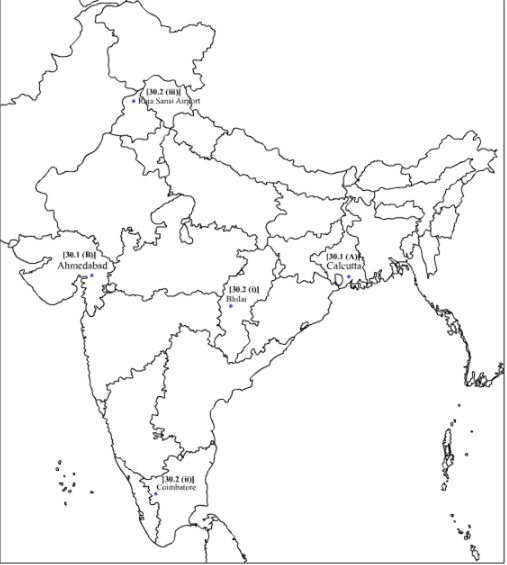
How had the First World War created a new economic situation in India? Explain with three examples.
The First World War created a new economic situation in India which are as:
(i) It led to a huge increase in defence expenditure which was financed by war loans and increasing taxes.
(ii) Customs duties were raised.
(iii) Income tax introduced.
How was Rowlatt Act opposed by the people in India? Explain with examples.
The Rowlatt act of 1919 was opposed in the following ways:
(i) Rallies were organised in various cities.
(ii) Workers went on strike in railway workshops.
(iii) Shops were closed down.
“Dalit participation was limited in the Civil Disobedience Movement”. Examine the statement.
Dalit participation was limited in the Civil Disobedience movement. The reasons for this were:
(i) Dr B.R. Ambedkar, who organised the Dalits into the Depressed Classes Association in 1930, clashed with Mahatma Gandhi at the second Round Table Conference by demanding separate electorates for Dalits.
(ii) When the British government conceded Ambedkar’s demand, Gandhiji began a fast unto death.
(iii) Gandhiji believed that separate electorates for Dalits would slow down the process of their integration into the society.
(iv) Dr. Ambedkar ultimately accepted Gandhiji’s position and the result was the Poona Pact of September 1932.
(v) It gave the Depressed Classes (later to be known as the Schedule Castes) reserved seats in provincial and central legislative councils, but they were to be voted in by the general electorate.
Sponsor Area
How did people and the colonial government react to the Civil Disobedience Movement? Explain.
Gandhi found in salt a powerful symbol that could unite the nation. He ceremonially violated the salt law and launched a civil disobedience movement in 1930.
Peoples’ reaction−Thousands from different parts of the country broke the salt law, manufactured salt and demonstrated in front of the government salt factories. As the movement spread, foreign cloth was boycotted, and liquor shops were picketed. Peasants refused to pay revenue and chaukidari taxes, village officials resigned, and in many places forest people violated forest laws − going into Reserved Forests to collect wood and graze cattle.
Government’s reaction − The colonial government began arresting the Congress leaders one by one. Abdul Ghaffar Khan, a devout disciple of Mahatma Gandhi, was arrested in April 1930. The government made the angry crowd face the armoured cars and police firing. Many were killed. When the industrial workers of Sholapur attacked police posts protesting against Gandhi's imprisonment, the government responded with a policy of brutal repression. Peaceful Satyagrahis were attacked and about 100,000 people were arrested.
Why did Gandhiji withdraw the Non co-operation Movement?
-
Gandhiji realized that people were losing interest in the movement.
-
Gandhiji felt the movement was turning violent in many places.
-
Some Congress leaders wanted to participate in elections to Provincial Councils.
-
Some Congress leaders wanted more radical mass agitations.
B.
Gandhiji felt the movement was turning violent in many places.
Which one of the following statements is false about Alluri Sitaram Raju?
-
He claimed he had special powers
-
He was inspired by the non-co-operation movement.
-
He believed in the principle of non-violence advocated by Gandhiji.
-
He persuaded people to give up drinking.
C.
He believed in the principle of non-violence advocated by Gandhiji.
Explain any three facts about the new economic situation created in India by the First World War.
The First World War created a new economic situation in India. The facts were:
(i) It led to a huge increase in defence expenditure which was financed by war loans and increasing taxes.
(ii) Customs duties were raised and income tax was introduced.
(iii) Through the war years prices increased-doubling between 1913 and 1918 - leading to extreme hardship for the common people.
“The plantation workers in Assam had their own understanding of Mahatma Gandhi and the notion of Swaraj”. Support the statement with arguments.
The plantation workers in Assam had their own understanding of Mahatma Gandhi and the notion of Swaraj. Plantation workers in Assam were kept in strict confinement and had to work for longer hours for meagre pay. Moreover, for the plantation workers, ‘swaraj’ meant the right to move freely in and out of the confined spaces and the freedom to visit their native villages. The workers after the beginning of the Non-Cooperation Movement, disobeyed the authorities, left the plantation and headed to their villages. The plantation workers believed that in the Gandhi Raj, every person would be given land in their own villages. However, they were caught by the police while on their way and were brutally beaten up. The plantation workers thus conceived the notion of swaraj in their own ways in which they thought that each of them will have freedom and land ending their poverty and miseries.
How did the Civil Disobedience Movement come into force in various parts of the country? Explain with examples.
Gandhi started the Civil Disobedience Movement in April 1930 by marching from the Sabarmati Ashram in Ahmedabad to the coastal town of Dandi. He defied the British authorities and the salt law by making salt from seawater. People in the rest of the country defied the British government by making salt and picketing shops selling liquor and foreign goods. As the movement spread, people refused to pay the revenue and village officials resigned. Khan Abdul Ghaffar Khan led the movement in Peshawar. When he was arrested by the police, the people became violent. In the villages, the rich peasant communities, such as the Patidars of Gujarat and the Jats of Uttar Pradesh, hit by the depression and falling prices of the crops were actively involved in the Civil Disobedience Movement. They organised people across their communities to follow the Civil Disobedience Movement. The rich businessmen and industrialists like G. D. Birla supported the movement. They refused to trade in foreign goods. The industrial class did not participate in the movement except in the Nagpur region. Women participated in the movement in large numbers.
Describe the spread of Non-Cooperation Movement in the countryside.
From the cities, the Non-Coperation Movement spread to the countryside. It drew into its fold the struggles of peasants and tribals which were developing in different parts in the years after the war.
(i) The movement was primarily against talukdars and landlords who demanded from the peasants exorbitantly high rents. By swaraj they understood that they would not be required to pay any taxes and that land would be redistributed.
(ii) In Awadh, peasants were led by Baba Ramchandra-a sanyasi who had earlier been to fiji as an identured labourer.
(iii) Alluri Sitaram Raju was a tribal peasant leader. During the days of Non-Cooperation Movement, he led the tribal people in the Gudem Hills of Andhra Pradesh.
How did 'Salt March' become an effective tool of resistance against colonialism? Explain.
The 'Salt March' acted as an effective tool of resistance against colonialism because it involved a stirring demand against the abolition of tax. Salt was something consumed by the rich and the by the rich and the poor alike. The tax on salt and the government monopoly over its production revealed the most oppressive face of British rule. To peacefully defy the British, Mahatma Gandhi started his famous salt march accompanied by 78 of his trusted volunteers. On 6 April he reached Dandi, and ceremonially violated the law, manufacturing salt by boiling sea water.This also marked the beginning of Civil Disobedience Movement.
Explain any five major problems posed by the First World War in India.
The First World War created a new economic and political situation in India. The problems posed were:
(i) It led to a huge increase in defence expenditure which was financed by war loans and increasing taxes.
(ii) Customs duties were raised and income tax was introduced.
(iii) Villages were called upon to supply soldiers and forced recruitment was carried out in rural areas which caused widespread anger.
(iv) Through the war years prices increased-doubling between 1913 and 1918- leading to extreme hardship for the common people.
(v)Then in 1918-19 and 1920-21, crops failed in many parts of the country, resulting in acute shortage of food which was also accompanied by an influenza epidemic.
People of India had hoped that their hardships would end after the war was over. But that did not happen.
How did women participate in Civil Disobedience Movement? Explain.
Another important features of the Civil Disobedience Movement was the large-scale participation of women.
(i) they participated in protest marches
(ii) manufactured salt, and picketed foreign cloth and liquor shops
(iii) many went to jail
How did the industrialists relate to the Civil Disobedience Movement? Analyse their role.
Describe the significance of the Civil Disobedience Movement in the freedom struggle of India.
The significance Civil Disobedience Movement:
(i )People were asked to not only refuse cooperation with the British (as they had done in 1921–22), but also break the colonial laws.
(ii) Thousands in different parts of the country broke the salt law, manufactured salt and demonstrated in front of government salt factories.
(iii) As the movement spread, foreign cloth was boycotted and liquor shops were picketed.
(iv) Peasants refused to pay revenue and chaukidari taxes and village officials resigned.
(v) In many places, forest people violated forest laws by going into reserved forests to collect wood and graze cattle.
Three features A, B and C are marked on the given political outline map of India. Identify these features with the help of the following information and write their correct names on the lines marked in the map:
A. The place where the Indian National Congress Session was held.
B. The place where cotton mill workers organised a Satyagraha Movement.
C. The city related to Jallianwala Bagh incident.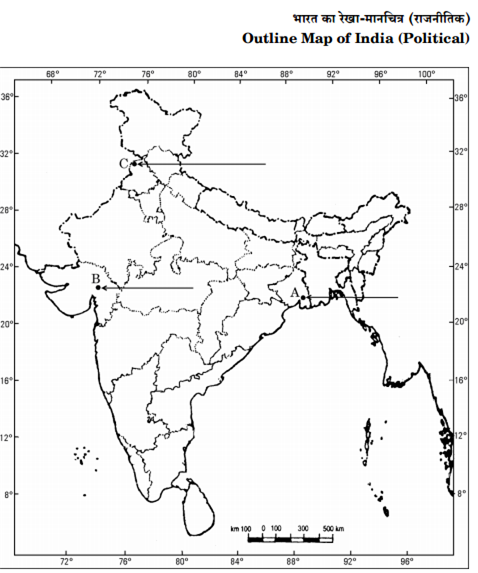
A. The place where the Indian National Congress Session was held - Kolkatta
B. The place where cotton mill workers organised a Satyagraha Movement - Ahmedabad
C. The city related to Jallianwala Bagh incident - Amritsar
Which one of the following statements is not related to the Gandhi-Irwin Pact?
-
Gandhiji agreed not to launch any further mass agitation against the British.
-
Gandhiji agreed to participate in the Round Table Conference.
-
Gandhiji decided to call off the Civil Disobedience Movement.
-
The British agreed to release the political prisoners.
A.
Gandhiji agreed not to launch any further mass agitation against the British.
How did the plantation workers understand the idea of ‘Swaraj’? Explain.
The plantation workers understood the idea of Swaraj as-
(i) The right to move freely in and out of the confined space in which they were enclosed.
(ii) It meant retaining a link with villages from which they had come.
(iii) They interpreted the Swaraj in their own ways, imagining it to be a time when all sufferings and all troubles would be over.
Explain four points about Gandhiji’s idea of ‘satyagraha’.
Gandhiji’s ideas of satyagraha were-
(i) Satyagraha emphasised the power of truth and need to search for truth.
(ii) It suggested that if the cause was true, if the struggle was against injustice, then physical force was not necessary to fight the oppressor.
(iii) Without seeking vengeance or being aggressive, a satyagrahi could win the battle through non-violence. This could be done by appealing to the conscience of the oppressor.
(iv) Gandhiji also believed that people had to be persuaded, instead of being forced, to see the truth through non-violence.
Two features (1) and (2) are marked in the given political outline map of India. Identify these features with the help of the following information and write their correct names on the lines marked in the map:
(1) The place, where the Indian National Congress Session of September 1920 was held.
(2) The place, where the movement of Indigo Planters took place.
OR
Locate and label the following features with appropriate symbols on the same political outline map of India.
(i) Amritsar − The place of Jallianwala Bagh incident.
(ii) Bardoli − The place were no tax campaign was held.
1. The place, where the Indian National Congress session of September, 1920 was held is Calcutta.
2. The movement of Indigo planters took place in Champaran.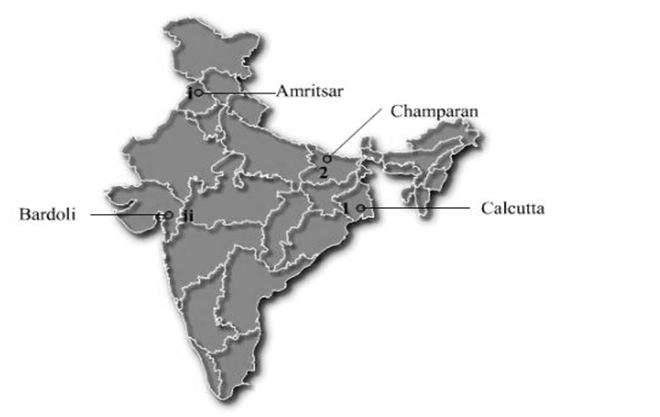
Why did Gandhiji decide to launch a nationwide Satyagraha against the proposed Rowlatt Act, 1919? Explain.
Gandhiji decided to launch a nationwide Satyagraha against the proposed Rowlatt Act, 1919 because it had the British government enormous powers to suppress political activities and allowed detention of political prisoners without trial for two years. The sucessfully organised satyagraha movements in various places had also emboldened Gandhi.
Describe the main features of the 'Salt March'.
Gandhi found in salt a powerful symbol that could unite the nation.
(i) Gandhi started his famous salt march accompanied by 78 of his trusted volunteers.
(ii) The march was over 240 miles, from Gandhi ashram in Sabarmati to the Gujarati coastal town of Dandi. The volunteers walked for 24 days, about 10 miles a day.
(iii) He ceremonially violated the British law when by manufacturing salt from sea water. This has also marked the beginning of the Civil Disobedience Movement.
How did different social groups conceive the idea of 'Non-Cooperation'? Explain with examples.
Different social groups conceived the idea of Non-Cooperation in their own way-
(i) The movement started with middle-class participation in the cities. Thousands of students left goverment-controlled schools and colleges, headmasters and teachers resigned, and lawyers gave up their legal practices.
(ii) Peasants participated in movement as they were against talukdars and landlords who demanded from peasants exorbitantly high rents and variety of other cesses.
(iii) Plantation workers participated in the movements with the hope that they would get the right to move freely in and out of the confined space in which they were enclosed.
(iv) The tribals in Andhra Pradesh joined the movement against oppressive British policies that prevented people from entering the forest to graze their cattle.
Which one of the following combination of colours was there in the ‘Swaraj flag’ designed by Gandhiji in 1921?
-
Red, Green and White
-
Red, Green and Yellow
-
Orange, White and Green
-
Yellow, White and Green
A.
Red, Green and White
D.
Yellow, White and Green
Explain the circumstances under which Gandhiji decided to call off the Civil Disobedience Movement in 1931.
The circumstances were-
(i) When Abdul Ghaffar Khan, a devout disciple of Gandhi, was arrested in 1930, angry crowds demonstrated in the streets of Peshawar, facing armoured cars and police firing. This led to violent clashes.
(ii) When Gandhi himself arrested, Industrial workers at Sholapur attacked all structures that symbolised British rule.
(iii) The government responded with a policy of brutal repression. Peaceful satyagrahis were attacked and about 100,000 people were arrested.
Explain the reactions of Indian people against the Rowlatt Act passed through the Imperial Legislative Council in 1919.
The reactions of people against the Rowlatt Act passed through the Imperial Legislative Council 1919 were-
(i) Rallies were organised in various cities.
(ii) Workers went on strike in railway workshops.
(iii) Shops closed down.
(iv) Mahatma Gandhi wanted non-violent civil disobedience against such unjust laws, for which a day of hartal was fixed on 6 April, 1919.
Why did Gandhiji decide to launch a nationwide Satyagraha against the proposed Rowlatt Act 1919? Explain any three reasons.
Gandhiji decided to launch nation wide satyagraha against Rowlatt Act in1919 because of the following reasons:
1. The terms and conditions of Rowlatt act were very obnoxious, they were violating of civil rights of Indians.
2. This act had been hurriedly passed through the imperial legislative council despite the united opposition of the Indian members.
3. Moreover, Gandhiji had already seen the success in satyagraha movements in regions like Champaran, Kheda. These had prepared the ground for a nation-wide satyagraha.
Evaluate the contribution of folklore, songs popolar points etc., in shaping the nationalism during freedom struggle.
In India the feeling of nationalism is associated with anti colonial movement. In the process of their struggle against the colonial yoke people began to discover their own identity of belonging to one nation. Various folk tales, songs, symbols like national flag, tricolour flag gave a sense of identity to the people. It gave a true picture of India's culture which was so rich and uncorrupted. They served to produce a sense of achievement and to glorify India's past.
1. National song like Vande matram instilled a sense of belongingness uniting people from different languages. Identity of India came to be associated with Bharat Mata was depicted as composed, divine, spiritual.
2. Folk tales, songs, hymns were used by our national leaders to give a sense of pride in our own culture.
3. Likewise Khadi, charka used by Mahatma Gandhi became symbols of agitation and resistance.
'Plantation workers had their own understanding of Mahatma Gandhi's ideas and the notion of 'Swaraj'.' Support the statement.
Workers had their own understanding of Mahatma Gandhi and the notion of swaraj. For plantation workers in Assam, freedom meant the right to move freely in and out of the confined space in which they were enclosed, and it meant retaining a link with the village from which they had come. Under the Inland Emigration Act of 1859, plantation workers were not permitted to leave the tea gardens without permission, and in fact they were rarely given such permission. When they heard of the Non-Cooperation Movement, thousands of workers defied the authorities, left the plantations and headed home. They believed that Gandhi Raj was coming and everyone would be given land in their own villages. They, however, never reached their destination. Stranded on the way by a railway and steamer strike, they were caught by the police and brutally beaten up.
What is meant by Satyagraha?
The idea of Satyagraha emphasized the power of truth and the need to search for truth. It suggested that if the cause was true and struggle was against injustice, then physical force was not necessary to fight the oppressor.
Evaluate the role of business classes in the 'Civil Disobedience Movement'.
The business classes supported the Civil Disobedience Movement when it was first launched. They gave financial assistance and refused to buy or sell imported goods. Most businessmen came to see Swaraj, as a time when colonial restrictions on business would no longer exist and trade and industry would flourish without constraints . But after the failure of the Round Table Conference, business groups were no longer uniformly enthusiastic. So, when the movement was re launched by Gandhi ji, most of them withdrew their support. They were apprehensive of the spread of militant activities and worried about prolonged disruption of business.
Explain the measures taken by Gandhiji to eliminate the problem of untouchability.
The efforts by Mahatma Gandhi to integrate untouchables in the national movements is as follows:
1.He called the untouchables’ as harijan, or the children of God,
2.He organised satyagraha to secure them entry into temples, and access to publicwells, tanks, roads and schools.
3.He himself cleaned toilets to dignify the work of the bhangi (the sweepers), and persuaded upper castes to change their heart and give up ‘the sin of untouchability’.
4.At the Karachi session of the Congress, in March 1931, Gandhiji drafted the Resolution on
5.Fundamental Rights. Few sections of it was a a legal attack on the institution of untouchability. Section 4 declared that all “citizens are equal before law, irrespective of caste, creed or sex”.
What type of flag was designed during the 'Swadeshi Movement' in Bengal? Explain its main features.
From the late nineteenth century the search for symbols of national unification emerged as one of the most potent driving factor of the national movement. With this aim the nationalists in Bengal designed a tri-colour flag for India. The three colours in this flag were red, green and yellow. This flag depicted both India as under the British and also that India which comprised of different sections of people. Thus the eight lotuses weer drawn on the flag to depict the eight provinces under the British India and a crescent shaped moon was depicted to represent the Hindus and Muslims.
'The plantation workers in Assam had their own understanding of Mahatma Gandhi and the nation of Swaraj'. Support the statement with arguments.
For plantation workers in Assam freedom means the right to move freely in and out of the confined space in which they were enclosed and it meant retaining a link with the village from which they had come. Under the Inland Emigration Act of 1859, plantation workers were not permitted to leave the tea gardens without permission, and in fact, they were rarely given such permission. When they heard of Non – cooperation movement, thousands of workers defied the authorities, left the plantations, and headed home. They believed that Gandhi Raj was coming and everyone would be given land in their own villages. They never reached home as they were stranded on the way by a railway and steamer strike, and were caught by the police and brutally beaten up. They interpreted the term Swaraj in their own ways, imagining it to be a time when all sufferings and troubles would be over.
How did the Civil Disobedience Movement come into force in various parts of the country? Explain with examples.
The civil disobedience movement started with the salt march from Sabarmati to the coastal town of Dandi. This was almost a 240 mile long march. The symbol of disobedience soon caught fire pan-India.
- Abdul Ghaffar Khan rose into revolt in Peshawar. He was soon arrested and the angry mobs broke into demonstrations in the city.
- Later, when Mahatma Gandhi was arrested, workers in Sholapur started attacking police posts and other government buildings.
- In the country side, rich peasant communities like the Patidars of Gujarat, and Jats of Uttar Pradesh were active in the movement. Being producers of commercial crops, they were very hard hit by the trade depression and falling prices. As their cash income disappeared, they found it impossible to pay the government’s revenue demand.
- And the refusal of government to reduce the revenue demand led to widespread resentment. These rich peasants became enthusiastic supporters of the Civil Disobedience movement, organising their communities and at times forcing reluctant members to participate in the boycott programmes.
- The industrial working classes did not participate in the Civil Disobedience movement in large numbers except in Nagpur region.
Explain any three measures taken by the British government to repress the movement started against the Rowlatt Act.
The following are the measures adopted by the British Government to repress the
movement started against the Rowlatt Act:
i. Fearing that railway and telegraph lines might be cut by those protesting the Act, the
Government unleashed harsher than usual measures to suppress the movement.
ii. Local leaders were imprisoned and Gandhi was prohibited from entering Delhi. On
10th April 1919, the police fired upon a peaceful procession in Amritsar.
iii. This action of the Government resulted in attacks on banks, post offices and railway
stations. Martial law was soon imposed and General Dyer took over the command.
Which were the two types of demands mentioned by Gandhi in his letter to Viceroy Irwin on 31 January 1930? Why was the abolition of ‘salt tax’ the most stirring demand? Explain.
Among the demands made by Gandhi in his letter to Viceroy Irwin, some of the demands were general in nature, whereas others were of interest to specific sections such as industrialists and peasants. The demand for the abolition of salt tax was the most important because it was a problem faced by Indians of all socioeconomic classes. Salt was and remains a product of daily consumption. Because it is naturally available in nature, the tax imposed on it was considered an injustice done to Indians. Gandhi’s letter gave the Government an ultimatum for accepting his demands, failing which he threatened to launch a Civil Disobedience Campaign.
Why did Gandhi start the ‘Civil Disobedience Movement’? Explain any four features of the movement.
Gandhi had made certain demands on behalf of the whole of the Indian National Congress to the British Government. When these demands were not fulfilled, the Civil Disobedience Movement was launched in 1930. The following are four important features of the movement:
i. The movement began with Gandhi’s march from Sabarmati to the coastal town of Dandi in Gujarat. On 6th April, Gandhi reached Dandi where he broke the salt law in defiance of the British by making salt from sea water.
ii. All classes and categories of people were now asked to not only be uncooperative of the British regime but also break unjust colonial laws.
iii. As soon as the movement started, all important leaders including Gandhi and Nehru were arrested. In all, 90,000 people were arrested and 67 newspapers were banned.
iv. During the movement, salt was manufactured in many areas, foreign cloth was boycotted, liquor shops were picketed and peasants refused to pay revenue and chaukidari taxes. A large number of village officials also resigned and forest laws were violated on a large scale.
Mock Test Series
Sponsor Area
Sponsor Area






